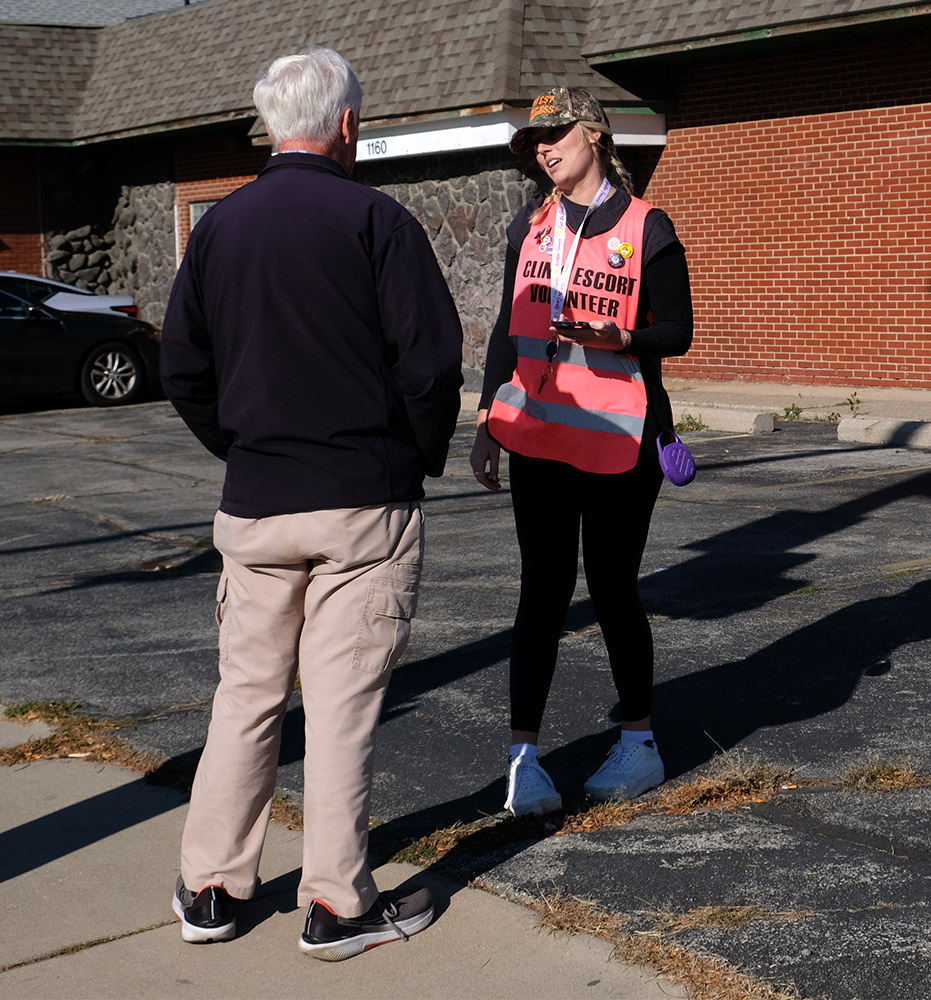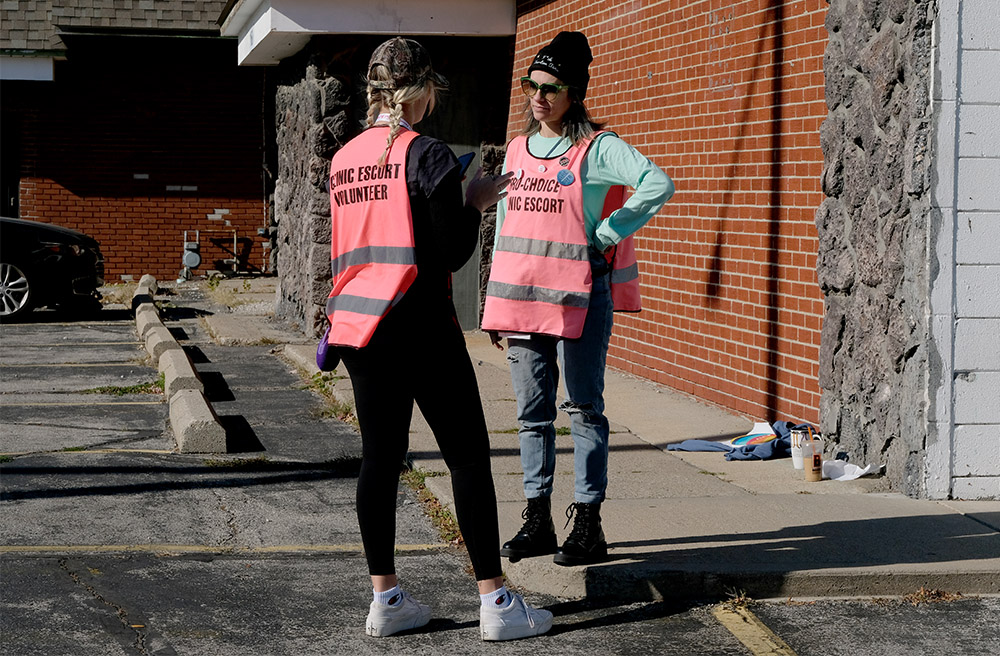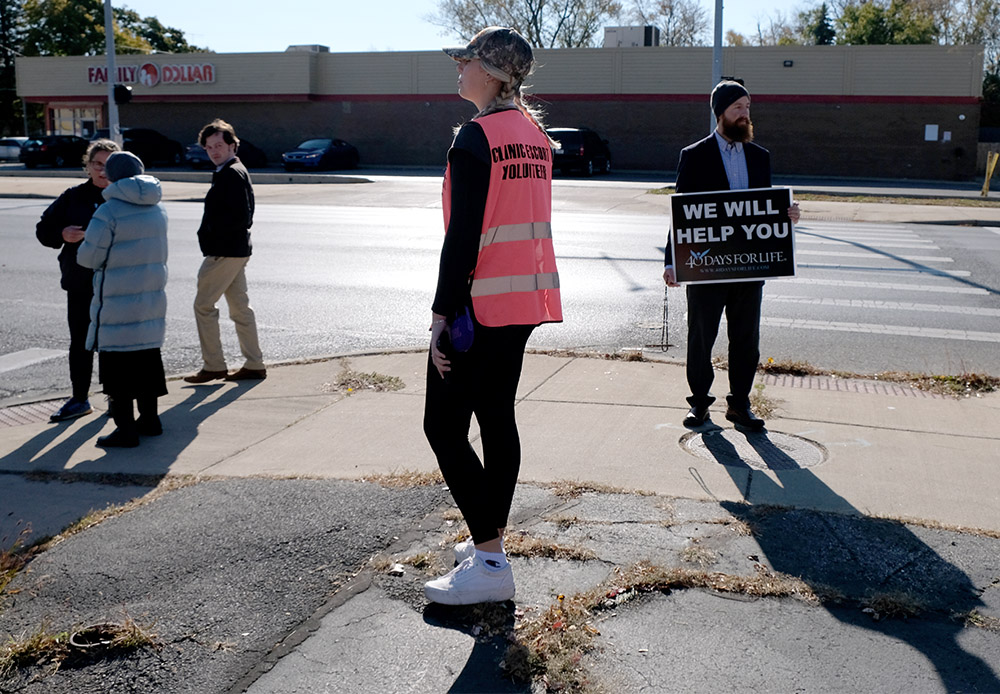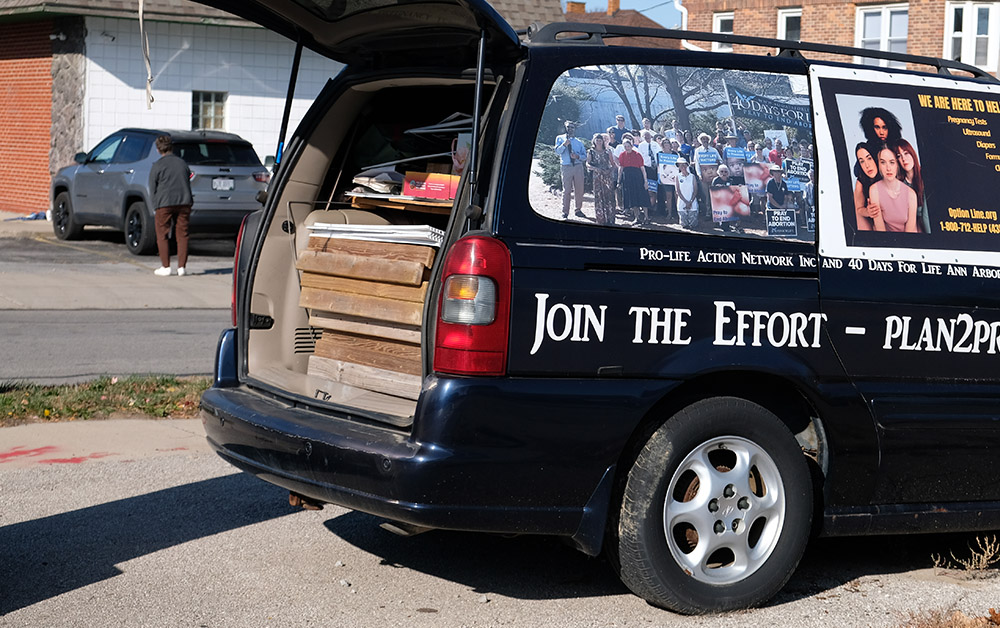Toledo Women’s Clinic & the Aggie Fund: Pro-choice movement in action
This is the second of a limited series about reproductive healthcare options and care for women in the Toledo area.
TOLEDO – When the Toledo Free Press caught up with Kristin Hady at Maddie & Bella in downtown Perrysburg, she was wearing a necklace with the word “abortion” on it, just in case anyone might be tempted to question her stance on reproductive rights.
Hady is a board member for The Aggie Fund, an organization founded in 1992 to fund abortions for residents of Toledo and surrounding areas. It is a volunteer-led, 501(c)3 organization that — at the time of this interview — had just hosted a bake sale fundraiser at the Toledo Women’s Center, which is Toledo’s sole abortion clinic.

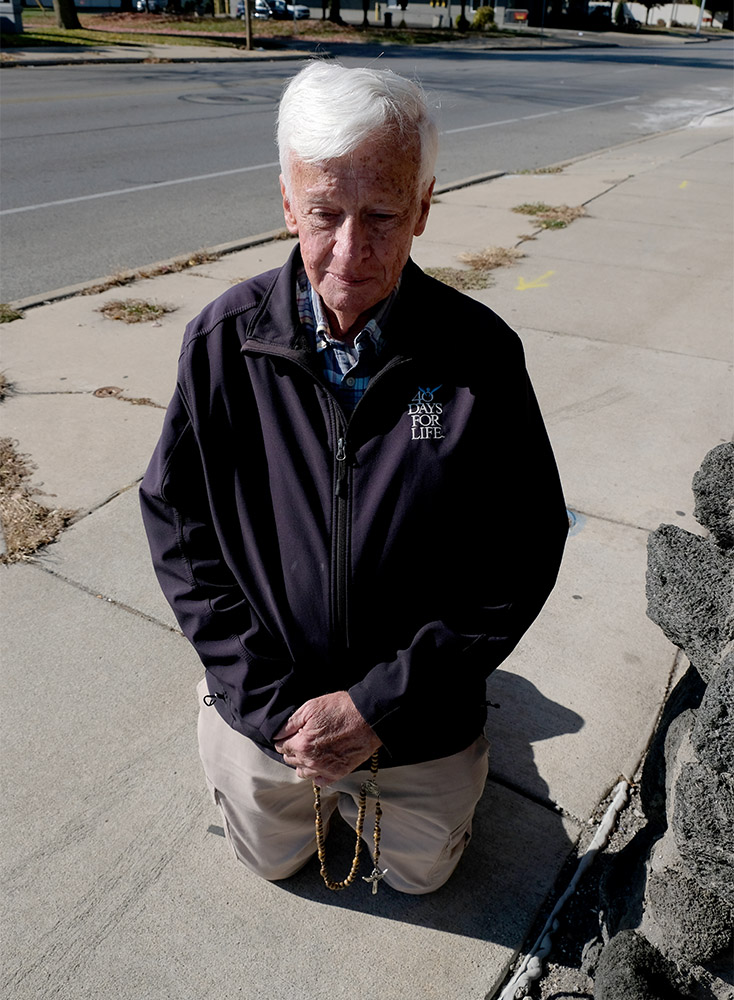
As a child growing up in Toledo, just a few blocks from the Women’s Center (formerly known as Capital Care Network), Hady didn’t have an understanding of the Center’s mission, but she did get the sense that it was controversial.
“We used to see this super old man that would walk the sidewalk with a giant cross on his back, but not realize what it was,” recalled Hady, referring to who she now recognizes as a likely anti-abortion protester.
Hady was inspired to abortion activism when she read work by Robin Marty, the author of Crow After Roe and Handbook for a Post-Roe America. The author’s account of a clinic escort’s experience made her want to work as an abortion escort, despite the details of that escort being harassed. She started volunteering for Toledo Abortion Center Escorts (TAC), and her activism snowballed from there.
“I became a clinic escort and the rest is history,” said Hady, adding she then started getting involved in other aspects of pro-choice advocacy in Toledo. “It’s like a gateway drug, you know; it starts here and then you go do everything else.”
Hady is referring to her service on two boards — The Aggie Fund and Abortion Forward (formerly Pro-Choice Ohio until a name change in May 2024) — as well as her full-time position as program director for Abortion Access Front.
What to know about The Aggie Fund
How does The Aggie Fund work? Essentially, the organization is funded primarily by community donations, but they are also part of the National Network of Abortion Funds collective. NNAF funding is distributed equally to abortion funds nationwide, including The Aggie Fund.
The Aggie Fund provides money for transportation, lodging and other logistical expenses, along with the money for the actual procedure (or pill). The abortion itself can cost between $600-$800, according to the Aggie Fund’s website. Because of demand, The Aggie Fund has to cap the amount of funds they disperse to make sure they can stay in operation.
The Toledo Women’s Center currently provides medication abortion up to 11 weeks and 6 days. Surgical abortions were provided at the Center about five years ago, but are not available at this time. However, the Center is in the process of being capable of providing surgical procedures in the near future.
“To ensure that we can still operate in a year, we have to unfortunately set monthly caps for how much we are able to fund out,” Hady said. “I don’t think there’s any fund in the country right now that is bringing in as much as they are spending monthly. We have 14 states with no abortion access anymore. Every time a state goes down, that ripples out; patients have to travel somewhere and, as the closest appointments fill up, the higher the costs are. Clinics are strapped.”
Hady adds that The Aggie Fund money goes to clinics like the Toledo Women’s Center, rather than directly to the patient. The Fund spent $9,860 on abortion costs for 76 patients from July 2020-June 2021; $42,812 on abortion costs for 162 patients from July 2021-June 2022; $140,744 for 405 patients from July 2022-June 2023; and helped an additional 51 patients from other states who needed to travel to get an abortion during that year (stats can be found at aggiefund.com). Their numbers have only increased since then.
“In ‘23 to ‘24, we’re probably going to get close to six figures — $200,000 — so our funding in four years has increased, you know, 2,000 percent,” said Hady, adding that “there’s a dearth of funding in the movement from the top down. The biggest funder of abortion, the National Abortion Federation, had to cut theirs. There are funds that run out every week, so when we unfortunately have to stick to our monthly budget, we are often out of additional money.”
In light of H.R. 271 – Defund Planned Parenthood Act of 2025, introduced to Congress on Jan. 9, it’s highly possible that funds for abortion providers — both large and small — will continue.
The Aggie Fund serves residents of northwest Ohio and southeast Michigan. Those who need help can see the map of counties they serve on their website here, along with links to other resources for those who live outside of those counties.
Pain point: The focus on trauma
In so many discussions about the life-threatening nature of limiting reproductive rights for women, many focus on the horror stories. Women who have pregnancy complications need abortions but can’t get them; women who miscarry and are denied care during their miscarriages; and other tragic stories that pull at the heartstrings of empathetic readers.
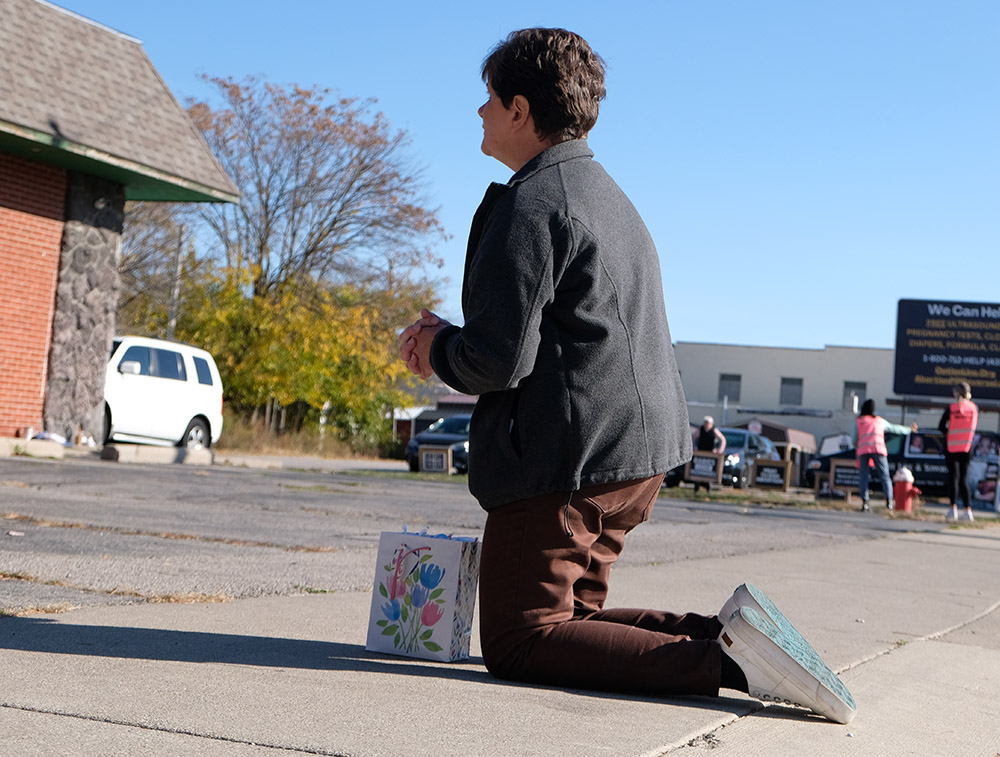

We asked Hady about any such scenarios she’s heard about from the women she helps, and her response was thought-provoking.
“I’ve talked to patients who had wanted pregnancies and then were diagnosed with cancer and had to get abortions. I’ve talked to patients who have six kids and just had another one and can’t afford them. Or, unfortunately, patients who may have been sexually assaulted. All of those stories we’ve heard are heartbreaking,” Hady said.
“But I also think sometimes we focus too often on the tragedy stories, and that we’re communicating that the only okay abortions are the ones that are…you have to have harm inflicted on your body to be deserving of it. No matter what their reasons, no matter their circumstances, we have to validate all abortion experiences.”
In other words, women shouldn’t have to have experienced tragic circumstances, like being raped, or having had a planned pregnancy go terribly wrong, in order to have an abortion. According to Hady and many other pro-choice activists, abortions without trauma should be viewed with an equal level of empathy and respect as those performed after a trauma.
Meet Amelia Stower: Toledo Women’s Center
There aren’t many 21-year-olds who can say they owned an abortion clinic, but Amelia Stower did. After the former owners of Toledo Women’s Center (still called Capital Care at the time) needed to step down in 2020, Stower took over for about 18 months. She was even the target of a lawsuit by Right to Life during her tenure.

“I took ownership in August [of 2020]; they didn’t hit me with the lawsuit until, I think it was the first week of March, and it was, coincidentally, right after we did a little hearing over getting a safety ordinance,” said Stower, explaining that she had publicly spoken about Center staff and patients being harrassed by pro-life protesters. She said that’s why they were proposing a “buffer zone” between the protesters and the Center.
The lawsuit filed against Capital Care and Stower claimed that because the organization and Stower herself did not have a medical license, they could not offer abortion services. “The thing is, they had been watching me since I took over ownership, so it’s just kind of funny timing to all of us that they chose then to suddenly go after me.”
On Feb. 16, 2024 the lawsuit was finally dropped with the following decision:
“Appellants, Right to Life Action Coalition of Ohio, Greater Toledo Area Right to Life, and Jeffrey Barefoot (collectively, “Right to Life”), appeal from the judgment of the Lucas County Court of Common Pleas dismissing their action against appellees, Capital Care of Toledo, LLC, D/B/A Capital Care of Toledo (“Capital Care”), 2. and Amelia Stower, on grounds of mootness.” (State ex rel. Right to Life Action Coalition of Ohio v. Capital Care of Toledo, L.L.C).
At 21, Stower received a full dose of what the conflict can be like on the abortion front, but she hasn’t backed down from the cause yet.
“I think it was a little bit of retaliation against me for speaking out,” she said. “But they also looked at my age, gender, and were like, ‘Oh, this might be easy. We can kind of scare her into shutting down.’”
Stower moved on from her role as owner so she could continue pursuing a degree at the University of Toledo, but she still has a very active role at the Center as assistant manager, a position that includes front desk administrative work, patient advocacy and funding management.
Complicated neighbors: The Center & The Haven
The Toledo Free Press covered The Pregnancy Center in September 2024, a story outlining what that organization does under the umbrella of the Bella Vita Network, a nonprofit that runs The Pregnancy Center, Soul Purpose and The Haven. The latter — a facility dedicated to counseling women and their partners who are coping with regrets post-abortion — is next to The Toledo Women’s Center.
Savannah Marten, the executive director of Bella Vita Network who we spoke to for that article, noted that the Center and the Haven have a “great relationship.”

Stower weighed in. “I would say they treat us with respect. Yeah, they’ve always been nice enough to us. As far as pregnancy centers go, they’re one of the better ones.” She is referring to “pregnancy centers” in the broader sense of the term: Facilities that give ultrasounds and are often operated by pro-life groups.
Hady had this to say about the group’s proximity to the center and how the two organizations co-exist, along with her own experience with Marten: “We are diametrically opposed on many things, but I like Savannah as a person. I understand the heart that she has for this work. So I have a good relationship with her, because we have to. We do share that property. We do share that driveway.”
An intricate web
Though the focus of this article is on the ways reproductive rights volunteers can get involved with the movement, each interview we do prompts more digging. What is the future of abortion in Toledo when only one clinic remains and offers medicated abortions?
Though The Pregnancy Center coincides relatively peacefully alongside its ideological opposites, what is the approach of other pro-life centers in the Toledo area? And, finally, how are women in Toledo coping with the ever-changing landscape of reproductive care in the U.S.?
If you have stories to share, reach out via our Story Tip Line.
The Mez debuts in warehouse space
Downtown Toledo has welcomed yet another upscale, lofted event space in what used to be a dilapidated, vacant warehouse at 710 Monroe St.
The Mez has been transformed into a cosmopolitan-style hotspot and is open for business, celebrating its grand opening on March 6 with an enthusiastic turnout of the town’s social mix. The space, where the Standard Pawn Shop resided for 40 years, sat empty for nearly a decade before being purchased by SVN Ascension Commercial Realty estate agent Stephanie Pilgrim.
Pilgrim said the application process began a couple years ago, and “we took advantage of the Facade and White Box grants for the whole building. Cody Brown and the city representatives were wonderful to work with. They were integral to getting this building revitalized and brought back to life.”

The building, built in 1892, was in dire need of a facelift, which is where the Façade Grant, provided by the city, was crucial. Its allotted money provides a 50 percent matching grant to reimburse expenses incurred during a comprehensive facade improvement, according to the city’s website.
Words like “upscale” and “lofted” give off vibes of plush throw pillows and million-dollar condos, but according to general manager Dani Bucher, the charm of the space is in its rustic atmosphere for weddings, corporate events and private parties. It accommodates up to 150 guests.

“We want this space to feel natural and organic for our clients,” she said, “With an historic building, we focused on adding amenities for the client and our vendors – trying to make sure they had great success and minimized any bumps in the road; making it seamless for them so they wanted to come back in the space and work hard at giving it a makeover.”
Along with keeping the historic feel to The Mez, Bucher and Pilgrim are focused on turning the entire building into an almost self–sustaining event center. Magnolia, a nightclub, has been a popular attraction since opening last summer. It sits on the third floor, its neon sign facing traffic.
As the city’s newest nightclub, Magnolia features live DJs, house music and bottle service every Friday and Saturday night.
“They attend to all of our bar service and beverage service,” Bucher said. “The upcoming restaurant and catering service will be something that we’d love to incorporate on the first floor.”
“When you have a multi-tenant building, it’s to everybody’s benefit to have great relationships with everyone,” said Pilgrim. “Eventually, the goal would be to get some type of speakeasy or wine cellar in the basement, which is the last space that’s open. It’s definitely going to take a unique investor to do that.”


It is those investors and grants which has given downtown some fresh breath. Nearly $250 million has been allocated into “catalytic projects,” such as the ProMedica corporate headquarters, under the Downtown Toledo Master Plan initiated in 2017. Since then, an additional $425 million in investments has been added.
Nearly three-quarters of the money has gone towards the construction of the Glass City Metropark, the renovation of the Glass City Convention and Event Center, bike paths running down Jefferson and Summit, and the planned renovation of 11 historic buildings, such as Fort Industry Square.
The economic impact has been gradual, but Summit St., for instance, looks alive at night, and especially on the weekends.
“We hope it’s a continuation of involving other businesses and playing our role in this on-going process,” Bucher said. “We’ve bartered with other businesses downtown and stayed engaged to experience great things together.”
“We’re confident that what we’ve done here is unique to the city. We wanted to go for the big-city vibe,” added Pilgrim. “We’ve teamed with Destination Toledo to become a great offering for those corporate events, and certainly we hope to get the wedding industry and more private parties here. I’m hopeful it has an economic impact on the city.”

New Mud Hens manager back in Toledo

TOLEDO – Thousands of Mud Hens fans poured into downtown Toledo on Friday, filling streets, bars, restaurants and Fifth Third Field to celebrate Opening Day 2025.
Though the Hens (0-2) started off strong with a solo home run by infielder and top prospect Jace Jung in the first inning, they lost 5-8 to the Columbus Clippers (2-0), led by manager Andy Tracy, a native of Bowling Green and BGSU graduate.


Nearly 13,000 ticket holders endured light rain at the start of the game, but by the third inning the sun poked through the clouds and fans settled into their seats to watch the Hens play under the direction of its new manager, Gabe Alvarez.
Alvarez comes to Toledo after having spent three seasons as the manager for the Erie Seawolves, the Double A affiliate for the Detroit Tigers.
In his three season in Erie, he compiled a record of 232-178 and was named the 2023 Eastern League Manager of the Year in 2023. In his time at Erie, he led the Seawolves to three division titles and two league championships. Before coming to Erie, he was an assistant coach and recruiting coordinator for the USC Trojans.

Although this will be Alvarez’s first year as the Mud Hens manager, he is no stranger to Toledo. He spent three seasons with the team in multiple stints from 1998 to 2000, and he looks back on his time here with great fondness. During that time, the Mud Hens played at Ned Skeldon Stadium in Maumee before moving into a brand new stadium at Fifth Third Field in 2002.
As a player, Alvarez played three season in the majors for the Tigers and Padres. He was drafted in the 2nd round of the MLB draft in 1995 by San Diego, retiring after an eight-year career in 2003.
“I remember how kind the fans were to me,” Alvarez recalled on Thursday during an interview on Media Day. “They always came out and supported us, and that’s something that’s special to a player or a coach.”

While winning is the goal in the major leagues, it’s not as simple in the minors with everyone trying to reach their goal of making the major leagues.
“The number one goal is to develop them as players and to help them get up to the big leagues,” Alvarez said. “I do believe part of their development is to compete to win the game, which is all that matters when you’re in the big leagues.”
Alvarez said he found out about his promotion to Toledo after the conclusion of last season, which included a few of his players he coached in Erie. He said he feels like that will be a good thing moving forward.
“It’s great. A lot of these guys and I have a great bond. We’ve been through a lot together,” Alvarez said.
Relief pitcher Pj Poulin was promoted from Erie to Toledo last July, and is excited to be back playing for the Mud Hens this year.
“I really love Toledo. I had a great time here last year for the half year I was here,” Poulin said. “The fans show up here, which is really cool.”
Mud Hens fan Luis Mata said the experience is always fun at Fifth Third Field.
“I really like the environment … the small stadium feeling. Feels like home,” he said.
The Hens fell 6-7 in their second consecutive game against the Clippers on Saturday.
The Mud Hens next home series begins April 8 against the Iowa Cubs.
On portal havoc, Eddie George staffing
On The Flyby Sports Podcast, co-hosts and school rivals Chas McNeil and Max Alfonso compare Bowling Green and University of Toledo athletics, specifically baseball, softball, basketball and just a bit of football.
For this episode, both McNeil and Alfonso dig into the transfer portal for men’s basketball as it wreaks havoc on both UT and BG, taking 11 players combined from the two schools.
The main topic is softball and baseball, which is reaching roughly the half-way point of their seasons.
They also highlight:
- last week’s action, athletes of the week
- a hot streak for BGSU softball
- transfer portal moves
- BGSU football’s head coach Eddie George’s coaching staff and Toledo’s struggles on the field
- a special Flyby episode featuring UToledo women’s head basketball coach Ginny Boggess
New episodes of the The Flyby Sports Podcast drop every Saturday.
The Flyby Sports Podcast is a production of the Toledo Free Press.
Stormin Norman’s last great sale
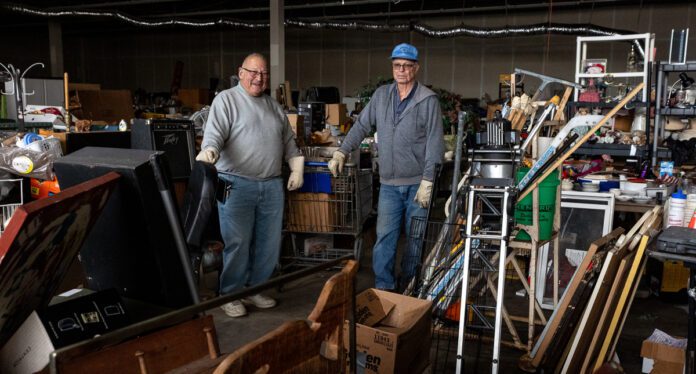
TOLEDO – For 15 years, Toledo’s own Stormin Norman‘s has been able to carve out a niche in retail with one focus: Quality products at low prices.
“We have a big, big name in this area for quality and low prices, and our clientele follows us,” boasted Norman Eisen, 68, the owner of Stormin Norman’s Wholesale Warehouse.
Eisen said he’s confident his clientele follow him because he’s moved four times and they have followed.
“We started off on Woodville Road [in the] Great Eastern Shopping Center, [then] we moved over to Alexis and Lewis, which worked out really well for us,” he said, accounting for where his business operated for the bulk of his life as a seller.

Unfortunately for Eisen, the property he was renting for his flea-market at Alexis and Lewis was sold to new owners when his lease was up last year, and he was forced to move yet again to his current, smaller location at 5517 Telegraph Rd.
“I’m going to a smaller scale, so I don’t have to work as hard, so I can enjoy my life a little more,” said Eisen, of west Toledo.
Large-scale flea-market dealing is what Eisen is known for, but he said he’s moving away from second-hand goods, focusing more on overstock and liquidation materials.
The quick-dealing seller, who asks people to make him an offer, explained his problem succinctly: “I’ve got TOO MUCH stuff.”
A large warehouse off Glendale Ave. holds the remnants of Eisen’s acquisitions – over 20,000 square feet of them.


“Norm had it set up so it’s like a garage sale,” said Ken Belkofer, 75, an auctioneer with 37 years of experience and a friend of Eisen’s.
“I’m not a garbage seller,” Belkofer said with pride as he started elevating the presentation of the goods.
Belkofer began auctioning and selling real estate back in 1988, and lives a semi-retired life.
“I didn’t think it was this bad,” he said as he relayed that he had been coaxed into helping Eisen because of their long-standing friendship.
“I need room for people to think,” Belkofer said of the massive inventory of odds-and-ends next to one another.
“I kept saying ‘no [to helping Eisen],’ and he kept saying, ‘yes, you are,” Belkofer summarized, and eventually Belkofer gave-in, qualifying his help.
“If it was June, I’d wanna’ go fishin,” he quipped, making it clear that the winter season played heavily into why he was lending his help.
Just for the record, Belkofer said he and his wife were signed up for another cruise, referring to their plans for warmer weather.

Sitting amongst the over-stocked inventory, the two aged men playfully chided one another. Eisen said Belkofer was addicted to auctioneering, and Belkofer said Eisen was getting too old for the business. But the words were said in good fun between old friends, with a hint of truth behind both of their claims.
“I want to empty this out as best I can and move on.” Eisen admitted. “I’m basically retiring.”
Eisen mentioned keeping the smaller location on Telegraph, but comparatively to how he’s run the business for the past decade, he’s downsizing quite a bit.
The two friends were eager to offload the inventory, and tried to do so many times to this Toledo Free Press reporter.
“How you’d do it is you could start to set it up outside,” Belkofer advised.
Just start having sidewalk sales,” Belkofer said in an effort to free up his time and be done with the project if the whole warehouse were to be bought in bulk.
Bulk buyers are welcome to inquire about buying the warehouse stock before the official auction, which Eisen and Belkofer hope to have ready by sometime in April.
TJGA readies for 2025 golf season
TOLEDO – One of the oldest junior golf associations in the country, the Toledo Junior Golf Association (TJGA), is set to begin its 52nd year and has posted the 2025 tournament schedule, along with new rules and scholarship opportunities.
TJGA first began hosting junior golf tournaments in the Toledo area in 1973 and has helped many young golfers improve their games for the high school season, with many of them going on to play collegiately.
TJGA has three divisions for both boys and girls based on age. Golfers aged 10-13 compete in the Futures Division. The next division is 14-15 with 16-19 year-olds in the oldest bracket.

In a rule change for 2025, golfers who turn 19 years old before or during the current season are now eligible to participate in TJGA events. Previously, only those players 18-years-old and younger were eligible to compete.
TJGA participants also compete in a season-long points competition to earn the Frank Stanahan Player of the Year (Boys) and the Sharon Keil Player of the Year (Girls).
Other annual awards include the Paul Hahn (Boys) and Karen Stone (Girls) Sportsmanship Award. In golf, “every shot counts;” that statement has never been more true to win either the Don Kotnik Boys Low Scoring, or the Greg Fish Girls Low Scoring Award at the end of the season.
High school seniors who play in TJGA events are also eligible to apply for three college scholarships:
- The Paul Szymanki Spirit Award Scholarship
- The Dr. Edward J Jacob Memorial Scholarship
- The Sharon and Jerry Keil Scholarship
Registration for these scholarships can be found at the TJGA website. Applications must be received prior to June 25.
The 2025 TJGA schedule features two events in May: The Joe Haas Cup at Firestone Country Club and the parent/child tournament, held at South Toledo Golf Club. Ten events are scheduled in June, plus seven tournaments in July.
June features the Maumee Bay Junior on June 3, followed by The Winckowski Law Office Open, hosted by Eagles Landing on June 4, and the Cam Smith Memorial Junior held at Stone Oak Country Club on June 6.
TJGA has been providing a competitive schedule of golf events for area junior golfers to hone their games and prepare for the future. Many former competitors have gone on to successful college – and even professional – golf careers.
The full schedule of 19 tournaments can be found at the TJGA website. Registration for the June events begins April 1 and registration for the July tournaments begins May 1.
Fire Chief Syroka: ‘Here to be servants’
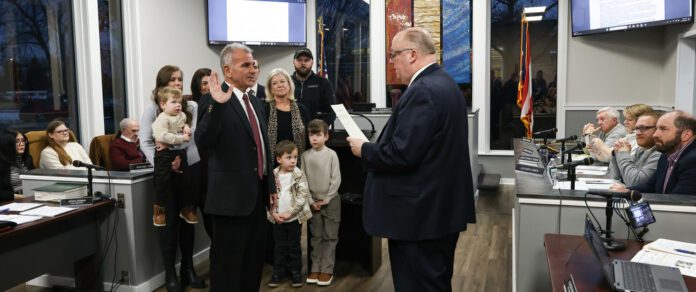
ROSSFORD – When Rossford’s new fire chief Rick Syroka was asked what he’s learned over the course of his long career, he answered, “We’re here to be servants.”
Despite retiring from the Toledo Fire and Rescue Department in 2022, he continues to live by that motto, once again serving the Rossford community as its new fire chief. He was sworn into office on Feb. 10; the cherry on top of his 36 years of fire service.
Before accepting the leading role at Rossford Fire Station 29, Syroka worked as a fire school instructor at the Bowling Green State University Fire School.
“I was retired for a little over two years, and the city came knocking on my door and asked if I would give them a hand, and that’s what I chose to do,” Syroka said.
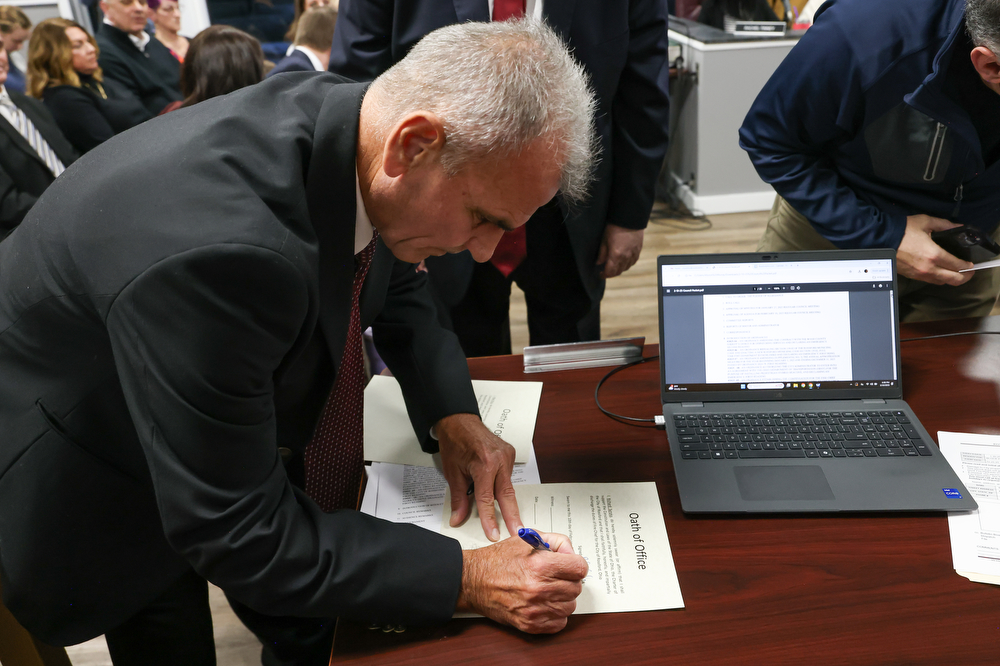
“Firefighters are problem solvers, and we get problems whether it’s in the engine house, [or] on the street. We like to solve problems and we like to use our hands to solve those types of problems,” Syroka said.
Syroka continues to problem-solve in his role as fire chief, and is using this skill to serve the community and his department.
“One of my goals is to make this a professional fire [department] that people will come and recognize and say, ‘Hey, I want to come to Rossford,’ or ‘I want to live in Rossford,’ not only for the fire service but for the community feeling as well,” Syroka said. “Rossford people have very high pride and respect for Rossford and the history of it, and I want to try to maintain that as much as I possibly can.”
This process of professionalization means Syroka is transitioning the department from part-time to full-time. Just a few weeks in office, Syroka has already hired eight new firefighters and would like to recruit more.
“We can provide a better service to the city and enhance firefighter safety if we can increase the daily staffing,” said assistant fire chief Ron Kay.
Syroka mentioned there seems to be less enthusiasm for firefighting jobs now than there were when he first became a firefighter.
“When I was taking tests [to be a firefighter], we had 3,500 people show up for a test, and now it’s very challenging to get people,” Syroka said.
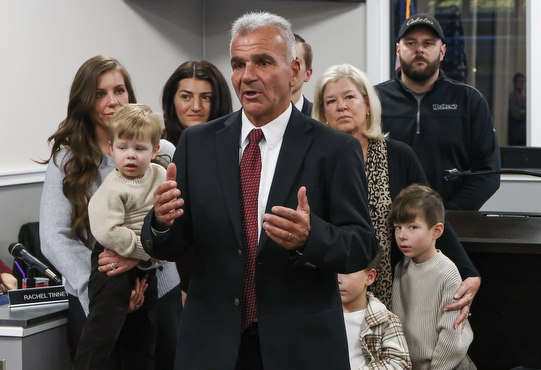
In addition to increasing staffing, Kay said Syroka has been updating the facilities to support full-time firefighters who need space to sleep and eat. Kay said these improvements include updating the kitchen appliances and dorms.
“I always thought highly of the Rossford Fire Department, and I knew there was a lot of potential here, especially with a lot of the growth that we’re seeing in the Rossford community. So, I thought, yeah, I would like to come on board and help them in this transition,” Kay said.
Despite all the changes that come with transition, Syroka said he has received a lot of support.
“The administration from the mayor on down have been fantastic. They have worked with me and told me things that they can do and things that they can’t, but they have been wonderful to work with,” Syroka said.



